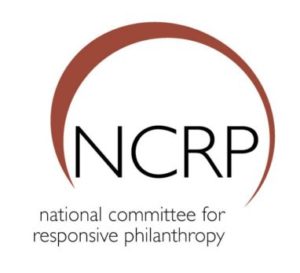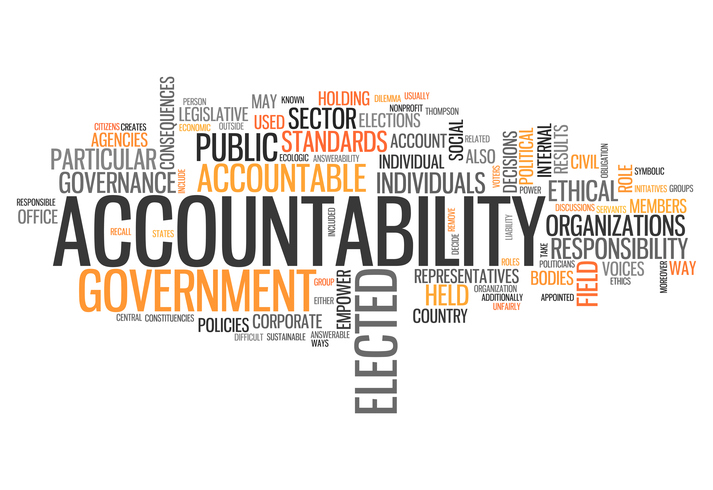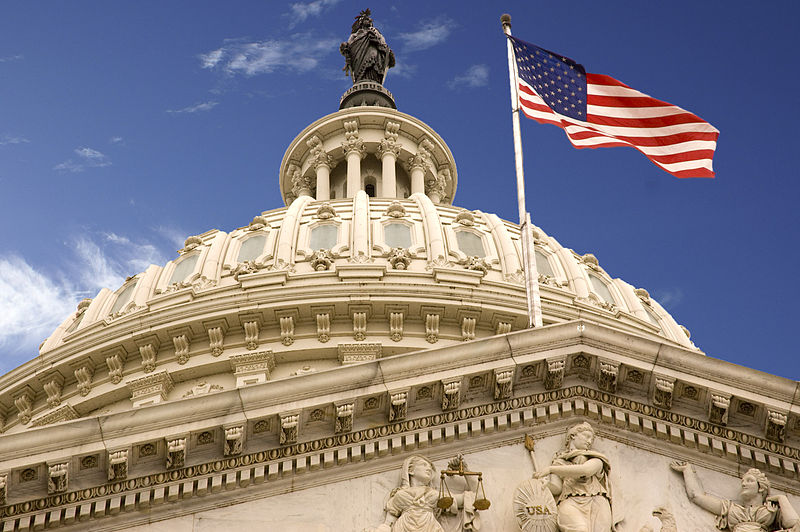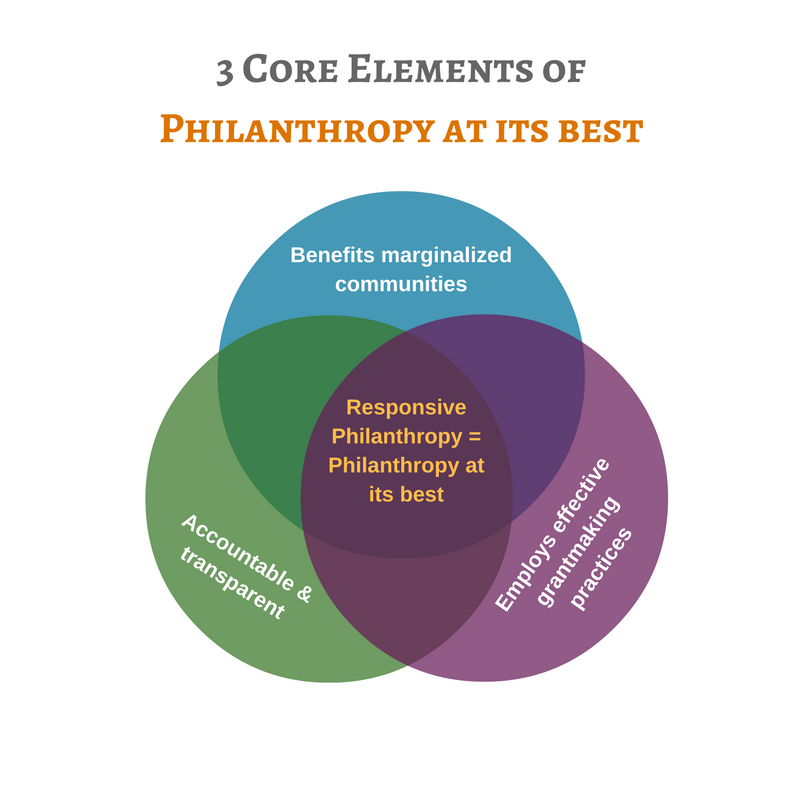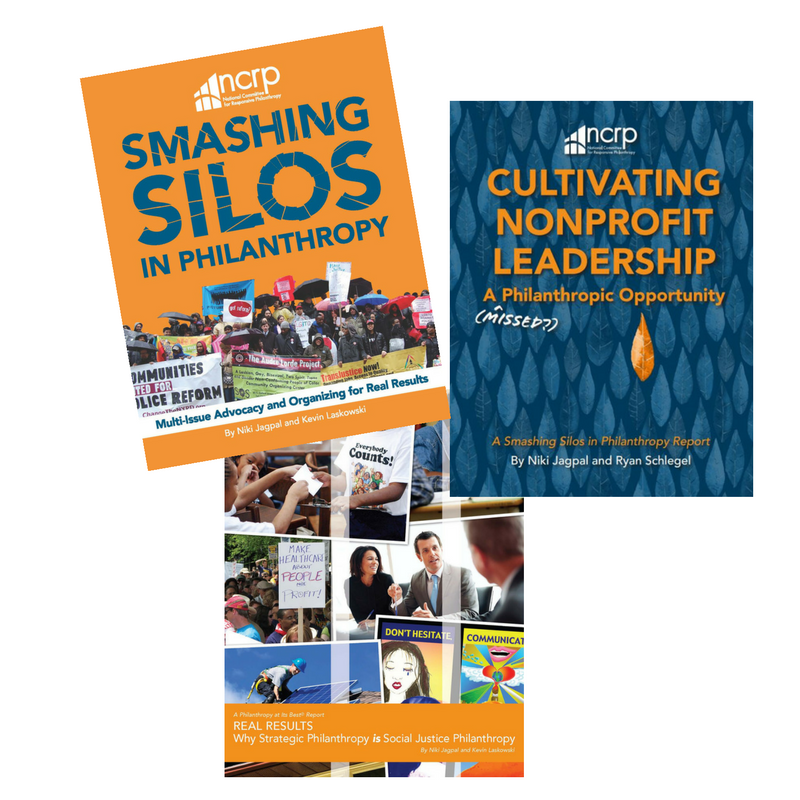Mission
NCRP promotes philanthropy that serves the public good, is responsive to people and communities with the least wealth and opportunity, and is held accountable to the highest standards of integrity and openness.
History
1976
THE DONEE GROUP FOUNDED NCRP
Pablo Eisenberg, Thomas R. Asher and Jim Abernathy founded NCRP with initial funding provided by John D. Rockefeller III, John Filer and Rockefeller Brothers Fund.
Historically, philanthropy as a sector was largely unregulated and unaccountable. After the Tax Reform Act of 1969, Congress began to closely examine foundations, which exerted tremendous social influence. In 1973, John D. Rockefeller III put together the Commission on Private Philanthropy and Public Needs, which would be also be known as the Filer Commission, named after its chairman, John H. Filer.
A coalition of public interest organizations, known as the Donee Group, organized to ensure that recipients of philanthropy are heard by the commission, which were largely represented by leaders in the business community, judges, religion leaders, university presidents and foundation executives.
Pablo Eisenberg, Thomas R. Asher and Jim Abernathy, prominent leaders from the Donee Group, founded NCRP with initial funding provided by John D. Rockefeller III, John Filer and Rockefeller Brothers Fund to ensure that the sector continued to address the issues that came out from the Filer Commission.
NCRP’s mission was to advocate for the philanthropic community to provide nonprofit organizations with essential resources and opportunities to work toward social and economic justice for disadvantaged and disenfranchised communities.
1979-2005
PUSHED A UNITED WAY TO BE RESPONSIVE TO COMMUNITIES OF COLOR AND FUND NONPROFIT ADVOCACY.
Historically, United Way’s track record in addressing social justice and the needs of marginalized communities was dismal. And since it had a monopoly on workplace giving, it was important to challenge them to improve their giving.
Through partnerships, conferences, media campaigns and local organizing, NCRP put the pressure on United Way. It also nurtured the development of alternative giving funds such as Community Shares, Earth Shares and Community Coalition Funds.
Between 2000 and 2002, alternative funds distributed more than $10 million annually to organizations promoting social justice causes.
NCRP also helped organized four of the first women’s funds from New Jersey, San Francisco, Seattle and Washington, D.C. These funds, along with the Women’s Way in Philadelphia, organized a conference in 1985 that resulted in the Women’s Funding Network.
Now, we see United Way embracing many of the things NCRP was pushing them to do. “Advocate” has been added to their tagline. They also do a much better job of investing in communities of color.
1979-1991
OPENED UP THE COMBINED FEDERAL CAMPAIGN TO ADVOCACY ORGANIZATIONS AND NONTRADITIONAL CHARITIES
Under the leadership of then executive director Robert Bothwell, NCRP pushed the CFC to allow the participation of nonprofit advocacy groups and nontraditional charities such as women’s groups and racial/ethnic groups.
Bothwell recounted in an impact study:
“We lobbied Congress to hold hearings on the CFC. Congress did. After the hearings in 1979, we lobbied the House Subcommittee on Civic Service to report out recommendations to open up the CFC. It did.
We lobbied the Carter Administration to implement the Subcommittee recommendations. The Civil Service Commission (forerunner of today’s Office of Personnel Management) did.
We organized a coalition to lobby congress to fight the Reagan Administration’s attempts to eliminate advocacy groups from the CFC. Others filed lawsuits.
With substantial effort from NCRP’s chief lobbyist, Raymond Brown, we were all successful year after year in winning battles to keep advocacy groups in the CFC, finally getting permanent legislation enacted in 1987, and good regulations enacted in 1988.”
Observers estimate that approximately $50 million of the total given out annually by the CFC is now going to benefit advocacy groups. That wouldn’t have happened without NCRP and its coalition partners for this campaign.
1980
INCREASED FOUNDATION TRANSPARENCY
Through a landmark report, NCRP called out the country’s largest private, corporate and community foundations for their lack of transparency and sparked a movement that has transformed the sector.
Foundations and Public Information: Sunshine or Shadow was the first real assessment of the quality of information that foundations voluntarily provided. The widespread media attention, including coverage by the New York Times, pushed many foundations such as the Pew Memorial Trust and Rockefeller Foundation, to begin publishing annual reports.
With the help of then Senator David Durenberger of Minnesota, the IRS agreed to add information requirements in 990PFs.
To this day, NCRP continues to push foundations to be more transparent with their operations and grantmaking by helping journalists with their investigative work, and through reports and initiatives such as Philamplify.
1980 – present
IMPROVED FOUNDATION ACCOUNTABILITY
Our campaigns and reports have pushed independent, corporate and community foundations to adapt practices that lead to increased accountability.
As the only independent watchdog of foundations, we used reports, testimonies and statements, and exposés to highlight questionable or egregious behavior, and promote ethical practices that serve the public good instead of private interests. These have pushed independent, corporate and community foundations to adapt practices that lead to increased accountability.
In 2004 we provided the first ever check list to help monitor foundation accountability. Standards for Foundation and Corporate Grantmaking, challenged the prevailing notion that foundations knew best.
And in the midst of the Great Recession, the country’s mega banks were using philanthropy to offset the bad press and threat of regulations that resulted from the key role they played in the great financial crisis of 2008. In Take and Give: The Crimes and Philanthropy of Bank of America, Wells Fargo Goldman Sachs and JP Morgan Chase, we analyzed the philanthropic claims of these banks based on transparency and verifiability, quantity and quality of their giving.
We also have served as resource to reporters investigating possible abuse and misuse of philanthropy such as the case against Jack Abramoff’s Capital Athletics Foundation, and authored exposes such as the one on Otto Bremer Foundation.
1989 – 1995
PUSHED NEARLY A DOZEN COMMUNITY FOUNDATIONS ACROSS THE COUNTRY TO DIVERSIFY THEIR BOARDS AND STAFF, AND TO INCREASE GRANTS THAT BENEFIT UNDERSERVED COMMUNITIES
A series of reports found that the community foundations in Atlanta, Boston, Chicago, Cleveland, Dallas, Denver, Los Angeles, San Diego and Seattle were too far removed from the communities they’re supposed to serve.
In 1993, following NCRP’s stinging critique from the past years, the community foundations in Atlanta, Boston, Los Angeles, Philadelphia and Seattle expended their grants to nonprofits serving the marginalized, and four of those five had significantly diversified their board and staff composition.
And now, The Denver Foundation is a recognized leader on diversity, equity and inclusion.
1995 – 2004
SHAPED THE WAY PROGRESSIVE FOUNDATIONS DEPLOYED RESOURCES TO STRATEGICALLY EFFECT PUBLIC POLICY
NCRP’s seminal series of reports on the role of foundations in politics was a critical point in the history of the progressive movement.
How did conservative foundations manage to build an effective infrastructure for developing and promoting conservative public policies with such limited resources?
This question was answered by Sally Covington in Moving a Public Policy Agenda: The Strategic Philanthropy of Conservative Foundations in 1997. It paved the way for the establishment of progressive think tanks such as the Center for American Progress, and contributed to the formation of the Democracy Alliance.
The follow up report Axis of Ideology: Conservative Foundations and Public Policy in 2004 has been used by dozens of groups to grow a base of political and charitable donors in support of progressive causes.
These and other reports such as David Callahan’s $1 Billion for Ideas: Conservative Think Tanks in the 1990s continue to shape how foundations think about their grantmaking strategies and the change they’re working to see in the world.
2009
REFOCUSED OUR WORK ON DEFINING AND PROMOTING PHILANTHROPY AT ITS BEST
Under a new leadership and guided by a new strategic plan, NCRP refocused its mission on the core tenets of philanthropy at its best.
The release of Criteria for Philanthropy at Its Best: Benchmarks to Assess and Enhance Grantmaker Impact caused a firestorm in the philanthropic sector, with critics complaining about the assignment of rigid metrics for exemplary philanthropy.
The controversy helped focus conversation in the sector about who benefits from foundation giving, and which practices really lead to impact and results.
2009 – present
REFRAMED “STRATEGIC PHILANTHROPY” AROUND EQUITY AND SOCIAL JUSTICE
How funders give and who benefits from philanthropy are just as important as how much they give to truly make a lasting positive impact. “Data,” “evaluation,” “effectiveness” and “impact” have become buzzwords as the sector strove towards “strategic philanthropy,” and have challenged foundations to think about the ways they give. But NCRP found that there was a lack of focus on those communities and organizations that philanthropy is supposed to serve.
NCRP’s research and campaigns pushed the sector to think beyond technocratic approaches to giving. How funders give and who benefits from philanthropy are just as important as how much they give to truly make a lasting positive impact.
2011 – present
TOP U.S. FOUNDATIONS PLEDGED TO DEDICATE TO UNDERSERVED COMMUNITIES
Top U.S. foundations pledged to dedicate at least 50 percent of grants for underserved communities and at least 25 percent for long-term systemic change.
More than 200 foundations representing close to 10 percent of all domestic grantmaking have committed to prioritizing and empowering underserved communities. Learn more about our Philanthropy’s Promise.
2012
DOCUMENTED THE RETURN ON INVESTMENT FOR FOUNDATION FUNDING OF ADVOCACY
Finally, there’s no doubt that foundation investments in advocacy, community organizing and civic engagement have substantial, tangible benefits for families and communities.
Most foundations in the sector don’t fund strategies that have been proven to lead to tangible lasting benefits for marginalized and underserved communities by addressing root causes of social problems.
Through its Grantmaking for Community Impact Project, NCRP examined the impact of 110 advocacy-oriented nonprofits in seven different parts of the country, and documented beyond a shadow of a doubt that foundation investments in high-impact strategies such as advocacy, community organizing and civic engagement have substantial, tangible benefits for families and communities. In fact, the ROI is $115 to $1.
Leveraging Limited Dollars: How Grantmakers Achieve Tangible Results summarizes the findings of the research series and offers concrete ways that grantmakers can begin or expand support for positive social change.
2013 – present
OUTSTANDING FOUNDATIONS INSPIRE OTHER PHILANTHROPISTS WITH HIGH-IMPACT GRANTMAKING
NCRP’s Impact awards lifts up foundations that have shown bold leadership, commitment to diversity, equity and inclusion, and exemplary grantmaking.
2014 – present
ASSESSMENT TOOL BRINGS GRANTEES’ AND STAKEHOLDERS’ VOICES TO EVALUATING MAJOR FOUNDATIONS
Most of the assessed foundations have incorporated some of our recommendations to improve operations and grantmaking strategies.
2016
NEW STRATEGIC FRAMEWORK
Engagement with social movements and wealthy donors are important strategies to ensure that philanthropy is contributing to a fairer, and more just, democratic and equitable society.

